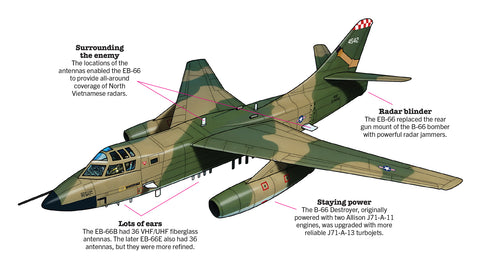
The EB-66 Destroyer: A Live Saving Intelligence Aircraft
At 8:05 a.m. on July 24, 1965, four F-4C Phantom II aircraft from the Air Force’s 47th Tactical Fighter Squadron were patrolling for MiGs that could threaten U.S. bombers southwest of Hanoi when two EB-66C Destroyer electronic warfare reconnaissance planes warned the F-4s about a surface-to-air missile launch. Seconds later three SAMs downed one of the Phantom IIs and damaged the others. That attack finally awakened the Pentagon to the SAM threat and the need for tactical aircraft with electronic countermeasures.
The Air Force EB-66, installed with those electronics, derived from the Navy’s A-3D-1 Skywarrior, designed in 1949 to carry a 5-ton nuclear weapon out to 2,300 miles. The Air Force wanted to purchase the Navy planes to replace its B-26 Invader bomber and RB-26 reconnaissance aircraft, but the required modifications delayed production until 1957. The new bomber became the B-66 Destroyer. The reconnaissance version was the RB-66.
Equipped with electronic sensors and photographic equipment, the first RB-66s arrived in South Vietnam on April 9, 1965. The aircraft was designated the EB-66 in 1966. Its variants—the EB-66B and EB-66C—worked in tandem. The EB-66C detected and identified enemy radars for the EB-66B to jam.
GET HISTORY 'S GREATEST TALES—RIGHT IN YOUR INBOX
Subscribe to our HistoryNet Now! newsletter for the best of the past, delivered every Wednesday.
Close
Thank you for subscribing!
Submit
The EB-66 aircraft often worked in concert with Marine EF-10B Skyknight and Navy EKA-3B Skywarrior planes that accompanied attack aircraft to blind enemy defenders along the route. They also guided “Wild Weasel” fighter-bombers hauling missiles targeting SAM sites. The EB-66E with specialized communications intercept and jamming equipment joined the war in 1967.
North Vietnam’s air defenders quickly understood the EB-66 planes’ importance and tried to engage them with SAMs and MiGs, often employing radar emission tactics to draw the EB-66 within engagement range.
By 1972, the Air Force’s EB-66B, C and E’s capabilities and less restrictive rules of engagement enabled them and their Navy electronic partners to all but paralyze Hanoi’s air defenses during the Linebacker II bombing campaign Dec. 18-29, 1972. The Air Force retired the last EB-66 in 1974.
Recommended for you
The EB-66—the Air Force’s only electronic intelligence aircraft in Southeast Asia—ensured the survival of hundreds of American air crews as it mapped and jammed Hanoi’s SAM radars.
EB-66 Destroyer
Crew: Three EB-66B; six to seven EB-66C and E
Engine: Two Allison J71 turbojets, with 10,000 lbs. thrust
Wingspan: 72 ft., 6 in.
Length: 75 ft., 2 in.
Max takeoff weight: 83,000 lbs.
Max speed: 630 mph
Cruising speed: 528 mph
Max. range: 2,529 miles
Mission endurance: Three hours
Service ceiling: 39,400 ft.
Electronics: AN/APR-25/26 radar homing and warning system; EB-66B and E:
C-I band jammers; EB-66C: A-J band receivers; EB-66E: AN/QRC-128
communications jammer
This article appeared in the Winter 2023 issue of Vietnam magazine.
historynet magazines
Our 9 best-selling history titles feature in-depth storytelling and iconic imagery to engage and inform on the people, the wars, and the events that shaped America and the world.
